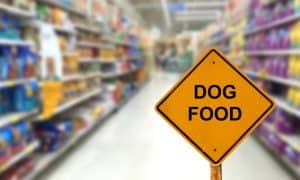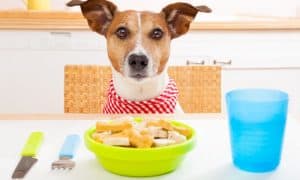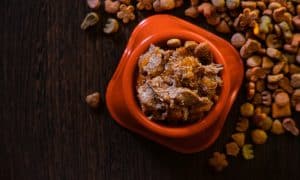“This post contains affiliate links, and I will be compensated if you make a purchase after clicking on my links.”
With so many varieties of pet foods available, all claiming to be nutritionally correct for your dog, it’s hard to know which is best for our pets. Veterinarian, Dr. Karen Becker, created this list of the 13 best and worst foods to feed your dog.
Any and all types of available and homemade diets are listed below. Find where your dog food choice stands in this list, and make it a goal to work your way up, for the health and wellness of your furry friends.
The Best (and Worst) Foods For Dogs
1. A balanced, raw, homemade diet is the best food you can feed your dog or cat. It will be nutritionally balanced because you’re following recipes like those found in the cookbook I co-authored, Real Food for Healthy Dogs and Cats.
Raw means the food is unadulterated and still contains all the enzymes and nutrients that are typically destroyed during cooking or other types of processing.
Homemade is the best option because you are in complete control of the quality of ingredients in your pet’s diet.
I recommend pets get plenty of nutritional variety, and another great thing about serving homemade is you can buy seasonal fruits and veggies on sale, as well as protein sources (meats), and use them in rotation.
2. The next best thing you can feed your pet is a commercially available raw diet. This is a raw food diet that someone else has done the heavy lifting to prepare.
It’s important that the diet is balanced, and you should be aware that there are raw food pet diets entering the market that are not yet proven to be nutritionally complete. These foods often say “For supplementation or intermittent feeding” on the label.
You’ll know if the raw food you’ve selected is balanced because it will say it right on the packaging: “This food has been proven to be nutritionally complete or adequate for all life stages.”
At the present time, these diets are found only in the freezer section of small/privately owned or upscale pet boutiques – not in the big box pet stores. You can also find a selection online.
3. Cooked, balanced homemade diet. It’s the same diet found in number 1, above, except that it’s cooked. This means some of the nutrient composition has been diminished through processing.
4. Human-grade canned food. If the label doesn’t say the ingredients are human grade, they’re not. Pet food made with human-grade ingredients is also a great deal more expensive, so that’s another way to tell what you’re getting.
This type of diet is the most expensive you can feed your pet. What I tell my clients is, “If you have more money than time, you can purchase human-grade canned food for your dog or cat. But if you have more time than money, I recommend you make a balanced, homemade diet right in your own kitchen for a fraction of the cost.”
5. Human-grade dry food. As I discussed earlier, dry food is not as species-appropriate as a moisture-dense diet. Human grade is very important because the food is approved, in theory, for human consumption, which means it doesn’t contain low quality rendered by-products.
6. Super premium canned food which can be found at big box pet supply stores like Petco and PetSmart.
7. Super premium dry food.
8. Veterinary-recommended canned food. Vet recommended canned foods are purchased at your vet’s office or clinic. Typical brands are Science Diet, the Purina veterinary lines, Royal Canin and Waltham.
9. Veterinary-recommended dry food.
10. Grocery store brand canned food.
11. Grocery store brand dry food.
12. Semi-most pouched food. The reason this type of pet food is so far down the list is because in order for the food to remain “semi-moist,” an ingredient called propylene glycol is added. This is a scary preservative that is a second cousin to ethylene glycol, which is antifreeze. And while propylene glycol is approved for use in pet foods, it is unhealthy for dogs and cats. I do not recommend feeding any food that contains this additive.
13. Dead last on the list and the worst thing you can feed your pet is an unbalanced, homemade diet – raw or cooked. I’m seeing an increasing number of misguided pet owners in my practice who think they’re doing the right thing by serving their pet, say, a chicken breast and some veggies and calling it a day.
Yes, the food is homemade, but it’s nutritionally unbalanced. Pets being fed this way are showing up at my clinic with endocrine abnormalities, skeletal issues and organ degeneration as a result of deficiencies in calcium, trace minerals and omega fatty acids.
Read the entire text here. Now that you’re aware of the best and worst foods for dogs, are you happy with the decision you’ve made for your dog’s diet? If you find that your pet’s food is lower on this list, you may want to consider a change. Tell us your thoughts about doggie diets below.



















Elena
Apr 24, 2018 at 7:26 pm
But what IS a nutritionally balanced raw (or cooked) food homemade diet? This is like saying “hey don’t do these things that have been proven to cause cancer”, without telling you what the things are. Is it so hard to provide a recipe that would allow people to make the homemade diet? Otherwise you are just guessing and in that case you are in the worst category of unbalanced homemade diets. Come on.
Brandy Arnold
Apr 24, 2018 at 9:43 pm
It is impossible to list a single, one-size-fits-all, homemade raw or cooked diet that would be appropriate for all dogs that takes into consideration the individual dog’s age, size, weight, activity, dietary needs or restrictions, allergies, and lifestyle.
Michael J Considine Jr
Jan 25, 2012 at 2:49 am
While I agree with some of the list, I actually have a no feed list and sadly that includes some formulas that Vets recommend and sell… I would not feed my dog any formulas that include ingredients like the ones listed in the Iams Veterinary formula listed below… the first two ingredients are deal killers for me and why any Vet would sell a formula that includes a meat by-product is beyond me… well I do know but I won’t get into that here.
Iams Veterinary Formula Weight Loss Restricted Calorie Dry Dog Food
Ingredient List
Corn Grits, Chicken By-Product Meal, Ground Whole Grain Sorghum, Ground Whole Grain Barley, Dried Beet Pulp (sugar removed), Natural Chicken Flavor, Dried Egg Product, Fish Meal (source of Fish Oil), Chicken Fat (preserved with Mixed Tocopherols, a source of vitamin E, and Citric Acid), Brewers Dried Yeast, Potassium Chloride, Dicalcium Phosphate, Calcium Carbonate, Sodium Hexametaphosphate, Fish Oil (preserved wih ethoxyquin), Choline Chloride, DL-Methionine, Flax Meal, Chromium Tripicolinate, Ferrous Sulfate, Vitamin E Supplement, Zinc Oxide, Vitamin A Acetate, Ascorbic Acid, Ethoxyquin (a preservative), Manganese Sulfate, Copper Sulfate, L-Carnitine, Manganous Oxide, Beta-Carotene, Calcium Pantothenate, Biotin, Rosemary Extract, Thiamine Mononitrate (source of Vitamin B1), Vitamin B12 Supplement, Niacin, Riboflavin Supplement (source of Vitamin B2), Inositol, Pyridoxine Hydrochloride (source of Vitamin B6), Vitamin D3 Supplement, Potassium Iodide, Folic Acid, Cobalt Carbonate
Dog parents need to educate themselves on how the AAFCO (Association of American Feed Control Officials) and the FDA has been controlled and manipulated by the pet food industry into allowing them to legally misrepresent the ingredients listed on their products and deceive the dog parents with current labeling laws.
Lila Solnick
Jan 24, 2012 at 1:06 pm
Great article. I HIGHLY recommend Karen Becker’s book, “Real Food for Healthy Dogs and Cats”. I’m on my second copy (I gave the first to a friend so that he could heal his sick cat). The information is invaluable, if you want to keep vet bills to a minimum and the health of your pet to the maximum. I have cats (oooh did I say a bad word here?) which are slowly being transitioned to a raw diet. The book is a huge help.